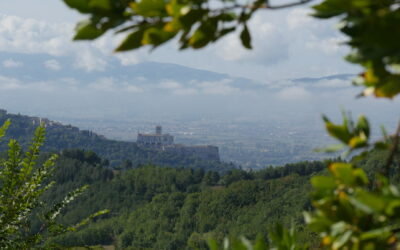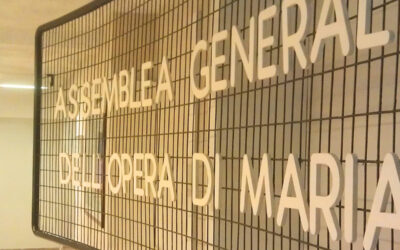The mystery of Jesus crucified and forsaken key to unity among the Churches
Ecumenism – Switzerland
28/10/2002
![]()
 “The spirit that animates the Focolare Movement is, in a certain sense, the same spirit that animates our Council which was created for the purpose of forming a fraternity of Churches.” This, according to Lutheran pastor Konrad Raiser, Secretary General of the World Council of Churches (WCC), explains why Focolare Movement founder Chiara Lubich was invited to address the Plenary Assembly of the members of the Council. “Chiara Lubich and her collaborators,” he continued, “are committed to finding ways to translate the spirituality of unity into new forms of harmonious living that connect us together particularly in this moment when the Council is searching for new ways to express itself.” The meeting took place in the auditorium of the modern Council building in Geneva that houses this 50-year-old organisation, the largest of its kind, bringing together persons of 342 Churches in 157 countries. Chiara Lubich had been asked to speak from the heart of her charism about the “key” to unity: Jesus crucified and forsaken. Her words helped the audience penetrate the mystery of love of a God who suffers the abandonment on the part of the Father in order to unite humanity to God and human beings with one another. Jesus forsaken, who assumes all the countenances of suffering and the pain of divisions so as to “give sight to the blind, hope to the desperate, victory to the fallen, unity to those who are separated.” Chiara explains that “in Jesus forsaken one finds the light to recompose the full visible communion of the one Church of Christ.” “We can see him,” she continues, “as ‘the ecumenical crucified one.’” Dr. Raiser commented immediately after Chiara’s address, “I sensed in her words the echo back to the intuition that was at the basis of the search for unity and that has been its program since 1925: ‘the closer we get to the cross of Christ the closer we get to one another. Beneath the cross we can reach out our arms towards the other.’” Catholic Bishop Kurt Koch of Basel, Switzerland, vice president of the Swiss bishops conference, gave a positive interpretation of the crisis being felt in the ecumenical movement. “We can use the word crisis in the sense that it’s time now to find new pathways. Only if we recognise Jesus forsaken in this lacerated body of Christ and we head right in to this suffering we can find new ways to reach unity.” Vatican Radio News Service “The spirit that animates the Focolare Movement is, in a certain sense, the same spirit that animates our Council which was created for the purpose of forming a fraternity of Churches.” This, according to Lutheran pastor Konrad Raiser, Secretary General of the World Council of Churches (WCC), explains why Focolare Movement founder Chiara Lubich was invited to address the Plenary Assembly of the members of the Council. “Chiara Lubich and her collaborators,” he continued, “are committed to finding ways to translate the spirituality of unity into new forms of harmonious living that connect us together particularly in this moment when the Council is searching for new ways to express itself.” The meeting took place in the auditorium of the modern Council building in Geneva that houses this 50-year-old organisation, the largest of its kind, bringing together persons of 342 Churches in 157 countries. Chiara Lubich had been asked to speak from the heart of her charism about the “key” to unity: Jesus crucified and forsaken. Her words helped the audience penetrate the mystery of love of a God who suffers the abandonment on the part of the Father in order to unite humanity to God and human beings with one another. Jesus forsaken, who assumes all the countenances of suffering and the pain of divisions so as to “give sight to the blind, hope to the desperate, victory to the fallen, unity to those who are separated.” Chiara explains that “in Jesus forsaken one finds the light to recompose the full visible communion of the one Church of Christ.” “We can see him,” she continues, “as ‘the ecumenical crucified one.’” Dr. Raiser commented immediately after Chiara’s address, “I sensed in her words the echo back to the intuition that was at the basis of the search for unity and that has been its program since 1925: ‘the closer we get to the cross of Christ the closer we get to one another. Beneath the cross we can reach out our arms towards the other.’” Catholic Bishop Kurt Koch of Basel, Switzerland, vice president of the Swiss bishops conference, gave a positive interpretation of the crisis being felt in the ecumenical movement. “We can use the word crisis in the sense that it’s time now to find new pathways. Only if we recognise Jesus forsaken in this lacerated body of Christ and we head right in to this suffering we can find new ways to reach unity.” Vatican Radio News Service
“The spirit that animates the Focolare Movement is, in a certain sense, the same spirit that animates our Council which was created for the purpose of forming a fraternity of Churches.” This, according to Lutheran pastor Konrad Raiser, Secretary General of the World Council of Churches (WCC), explains why Focolare Movement founder Chiara Lubich was invited to address the Plenary Assembly of the members of the Council. “Chiara Lubich and her collaborators,” he continued, “are committed to finding ways to translate the spirituality of unity into new forms of harmonious living that connect us together particularly in this moment when the Council is searching for new ways to express itself.” The meeting took place in the auditorium of the modern Council building in Geneva that houses this 50-year-old organisation, the largest of its kind, bringing together persons of 342 Churches in 157 countries. Chiara Lubich had been asked to speak from the heart of her charism about the “key” to unity: Jesus crucified and forsaken. Her words helped the audience penetrate the mystery of love of a God who suffers the abandonment on the part of the Father in order to unite humanity to God and human beings with one another. Jesus forsaken, who assumes all the countenances of suffering and the pain of divisions so as to “give sight to the blind, hope to the desperate, victory to the fallen, unity to those who are separated.” Chiara explains that “in Jesus forsaken one finds the light to recompose the full visible communion of the one Church of Christ.” “We can see him,” she continues, “as ‘the ecumenical crucified one.’” Dr. Raiser commented immediately after Chiara’s address, “I sensed in her words the echo back to the intuition that was at the basis of the search for unity and that has been its program since 1925: ‘the closer we get to the cross of Christ the closer we get to one another. Beneath the cross we can reach out our arms towards the other.’” Catholic Bishop Kurt Koch of Basel, Switzerland, vice president of the Swiss bishops conference, gave a positive interpretation of the crisis being felt in the ecumenical movement. “We can use the word crisis in the sense that it’s time now to find new pathways. Only if we recognise Jesus forsaken in this lacerated body of Christ and we head right in to this suffering we can find new ways to reach unity.” Vatican Radio News Service “The spirit that animates the Focolare Movement is, in a certain sense, the same spirit that animates our Council which was created for the purpose of forming a fraternity of Churches.” This, according to Lutheran pastor Konrad Raiser, Secretary General of the World Council of Churches (WCC), explains why Focolare Movement founder Chiara Lubich was invited to address the Plenary Assembly of the members of the Council. “Chiara Lubich and her collaborators,” he continued, “are committed to finding ways to translate the spirituality of unity into new forms of harmonious living that connect us together particularly in this moment when the Council is searching for new ways to express itself.” The meeting took place in the auditorium of the modern Council building in Geneva that houses this 50-year-old organisation, the largest of its kind, bringing together persons of 342 Churches in 157 countries. Chiara Lubich had been asked to speak from the heart of her charism about the “key” to unity: Jesus crucified and forsaken. Her words helped the audience penetrate the mystery of love of a God who suffers the abandonment on the part of the Father in order to unite humanity to God and human beings with one another. Jesus forsaken, who assumes all the countenances of suffering and the pain of divisions so as to “give sight to the blind, hope to the desperate, victory to the fallen, unity to those who are separated.” Chiara explains that “in Jesus forsaken one finds the light to recompose the full visible communion of the one Church of Christ.” “We can see him,” she continues, “as ‘the ecumenical crucified one.’” Dr. Raiser commented immediately after Chiara’s address, “I sensed in her words the echo back to the intuition that was at the basis of the search for unity and that has been its program since 1925: ‘the closer we get to the cross of Christ the closer we get to one another. Beneath the cross we can reach out our arms towards the other.’” Catholic Bishop Kurt Koch of Basel, Switzerland, vice president of the Swiss bishops conference, gave a positive interpretation of the crisis being felt in the ecumenical movement. “We can use the word crisis in the sense that it’s time now to find new pathways. Only if we recognise Jesus forsaken in this lacerated body of Christ and we head right in to this suffering we can find new ways to reach unity.” Vatican Radio News Service




0 Comments